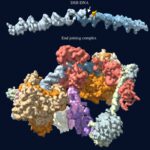Link to Pubmed [PMID] – 7966328
Link to DOI – 10.1006/jmbi.1994.1716
J Mol Biol. 1994 Nov 25;244(2):158-67.
The crystal structures of Thermus thermophilus aspartyl-tRNA synthetase and of its complex with ATP, Mg2+ and aspartic acid, show in situ formation of the amino acid adenylate and furnish experimental evidence for the modes of recognition of aspartic acid and ATP. The amino acid fits in a predefined specific site in which it replaces water molecules without significant conformational changes of the binding residues. This mode of selection is reminiscent of the lock and key concept. The pocket is closed by the movement of a histidine side chain from a neighbouring loop acting as a valve. ATP binding is driven by the stacking of the adenine upon the otherwise fixed aromatic ring of the class-II-invariant phenylalanine Phe235. Specific recognition is achieved by interactions with the flexible side chains of other class-II-conserved residues. Conformational changes have been identified which allow the description of a reaction pathway including both lock-and-key and induced-fit interactions. This pathway can presumably be extended to all class II aaRS.

